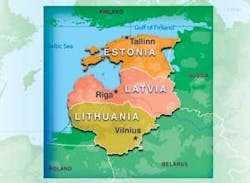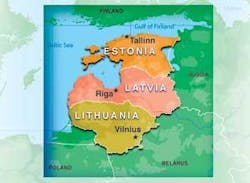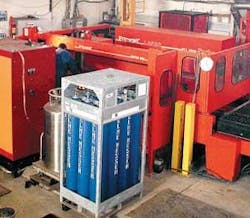Baltic Tigers rediscover laser technology
Current economic growth attracts laser development in Estonia, Latvia, and Lithuania
Gediminas Raciukaitis
The Baltic States attained “true” independence 15 years ago, after invasions and occupations subdued human consciousness and economic development. Opportunities in world markets, good education, and past experiences have assisted in forming a new image: the bridge between East and West in Europe.
Over the last five years, Estonia, Latvia, and Lithuania have shown rapid economic growth, with annual increases in gross domestic product (GDP) of 6-9 percent and with each country competing for leadership. This is why they are sometimes called the “Baltic Tigers.”
Despite rapid GDP growth, the amount per capita is only 36-42 percent of the European Union (EU) mean value because of a low salary structure. Western companies are inclined to move production to countries with high work ethics and cheap labor, for example Estonia where many Finnish companies have established subsidiaries. When the countries joined the EU in 2004 the new economic situation reinforced investments, opening the door to modern technologies such as industrial lasers.
History
In Lithuania, the first laser was started up in 1967 at Vilnius University, for research in semiconductors. Active groups of laser scientists grew up at the university and the Institute of Physics where research was directed to the generation of ultrafast pulses, parametric light conversion, and spectroscopic applications. Spin-off laser companies Ekspla Ltd. (www.ekspla.com) and Light Conversion Ltd. (www.lightcon.com) formed in the 1990s captured up to 60 percent of the world market in scientific applications segments. Laser microfabrication opened new possibilities for the lasers made in Lithuania to enter the industrial market.
Estonia is historically famous for its excimer lasers. At the University of Tartu discharge in gases and pulsed/CW excimer lasers are the main directions in laser science. Latvia never was a laser manufacturing country, but here laser spectroscopy has a history.
Laser technology development in Lithuania started at the Institute of Physics (Vilnius) in 1981 and was active until 1989. There scientists and engineers worked on laser hardening, alloying, cutting, and marking applications and as a result a number of CO2 and Nd:YAG lasers were installed in various factories of Lithuania. These factories collapsed after the restoration of independence burying their laser technologies. Only one Bulgarian 1.3kW CO2 laser for cutting stainless steel is still working from that time at AB Astra (Alytus).
Two job shops started work in 1995 with Russian-made 1.5kW lasers, providing services mainly to the advertisement industry. In 1997, AB Elga (Siauliai), a producer of equipment for voltage distribution, installed a Bystronic laser-cutting center, an experience that encouraged the spread of laser cutting technology.
Current situation
The new economic situation is bringing back laser technology, with more sheet metal cutting machines working in all the Baltic countries. Three types of companies use sheet metal cutting systems: for internal consumption, providing contract manufacturing, and acting as a branch of foreign companies, mainly Scandinavian (Finnish in Estonia, Norwegian and Danish in Latvia and Lithuanian).
Installation grew rapidly from 2000 with gains of 3-4 laser sheet metal cutting systems every year. In 2003, 11 installations set a record. Amada, Bystronic, and TRUMPF cover about ¾ of the market with representatives in the Baltic States. We estimate that about 30 cutting machines with high-power CO2 lasers are working in the Baltic States at the beginning of 2005.
In Lithuania, laser installations are concentrated in Vilnius, Alytus, and Siauliai. In Latvia, the city of Riga and its surroundings have the highest concentration (seven) of laser cutting systems. Tallinn and Tartu, two cities in Estonia, feature lasers used in science, higher education, and modern technologies.
Though sheet metal cutting dominates, there are a few tube-processing centers and some combination laser/punching ma-chines. Companies now running plasma and water-jet cutters are looking for laser machines. “We have grown up to buy the laser,” says V. Ruzgys, director of Karbonas Ltd. This contract manufacturing company, based near Kaunas (Lithuania), has traditionally worked with plasma and water-jet.
Baltkartons SIA, a Latvian company, runs Ferranti laser systems from Ferranti (Scotland) in the capitals of all the Baltic States, monopolizing the die board cutting market in the packing industry.
Spot welding of small metal parts for CRT tube guns at AB Ekranas (Panevezys) is the only production laser welding application in Lithuania. Four pulsed Nd:YAG lasers from Miyachi, Hitachi, and Ekspla have been working in the factory for about five years. A number of Nd:YAG spot welders with manual control (Kvant, Alpha, Baasel) are working in diverse applications ranging from stamp die repair to welding of jewelry and dental devices.
Laser marking and engraving are not used heavily in industrial applications, where making rubber stamps and personalizing gifts are the main applications for lasers, although marking ear-wear tags for animals is a small exception. At least eight companies use lasers for marking and engraving in Lithuania, the leader being Astuonetas Ltd. (Vilnius), the oldest laser job shop in the Baltic States, operating five Nd:YAG and two CO2 laser systems. Other companies active in laser engraving working in Latvia and Estonia have started to use lasers from international companies such as GCC.
Photonics industry picture
Estla Ltd. (Tartu), Semento Ltd. (Tallinn), and Neweks Ltd (Tallinn) are Estonian companies that manufacture excimer lasers with power ranging to 20 W. These companies, with total sales of about 1000 units, are leaders in the low-power excimer laser segment. Their lasers are used for lithography at research institutes and universities in the U.S., Japan, and Europe, but none of these devices are installed at home for industrial applications.
Anda Optec Ltd, a company from Daugavpils, Latvia, produces fibers for medical lasers, UV fiber bundles, and laser beam delivery systems. Ten other small companies in Latvia are associated with optics and holographic recording and mass replication.
Vilnius, the Lithuanian laser center, has 10 companies producing lasers, optical components, and related services. Eksma Ltd. (www.eksma.lt) is well known internationally for optics and nonlinear crystals. It pioneered in the production of glass intra-volume marking systems. Their equipment is employed for gift marking in job shops and on the production lines of companies such as Rolex (Switzerland). Since 2004, the photonics business has moved to its subsidiary, Ekspla Ltd. The company is active in the production of lasers and systems for research and industrial applications. Many picosecond and nanosecond lasers with fixed and wide-tunable wavelength are sold globally, and the company is developing new short pulse lasers for laser microfabrication. Light Conversion Ltd. designs, manufactures, and sells ultrafast parametric light generators, solid-state lasers, optical correlators and femtosecond lasers for industrial applications. Standa Ltd. (www.standa.lt) manufactures precision mechanics and opto-mechanical instruments and designs microchip lasers and solid-state lasers for medicine and industry. Geola Uab (www.geola.com) produces laser systems for holography, large format decoration, and security holograms.
The Laser and Optics Technology Association of Lithuania was founded in 2004 to coordinate efforts of the laser and photonics companies in Lithuania and attain growth of the laser industry to one percent of GDP.
Research
Scientists at Tallinn Technical University research pulsed laser deposition with excimer lasers and are planning research in laser welding. One research field at Kaunas University of Technology is hardening and alloying of steel with TiN. Tribological properties of laser treated surfaces are under investigation at Lithuanian University of Agriculture. Riga Technical University is working on laser annealing of Si on insulator structures. Experiments on direct laser writing on conductive structures of ITO and ceramics with a CW Nd:YAG laser are implemented at Daugavpils Pedagogical University (Daugavpils). In 2004 a laboratory for Applied Research was founded at the Institute of Physics, Vilnius with the main activity in laser microfabrication using short pulse lasers.
The Laser Research Center (LRC) at Vilnius University is a member of LASERLAB, a network connecting main laser centers in Europe. LRC provides training in quantum electronics, nonlinear optics, laser spectroscopy, and bio-photonics as well as for scientific research in physics of high pulse energy femtosecond solid-state lasers, nonlinear optics, and parametric generation.
Scientists in Riga, Tartu, and Vilnius are working in laser spectroscopy of atoms, molecules, and solids. Development of compact sealed excimer lasers, gas mixtures for them, and use of KrF lasers for cleaning heritage objects are activities at Tartu University.
These groups are involved in international research projects, supported by EU and NATO programs. The Structural Funds of EU are an impulse for the development and introduction of modern technologies in the Baltic States. They offer funding for renewal of the equipment at research institutes as well as in high-tech companies.
Dr. Gediminas Raciukaitis, [email protected]., is head of Laboratory for Applied Research, Institute of Physics, Vilnius, Lithuania, and consultant on laser technology with Ekspla Ltd.




